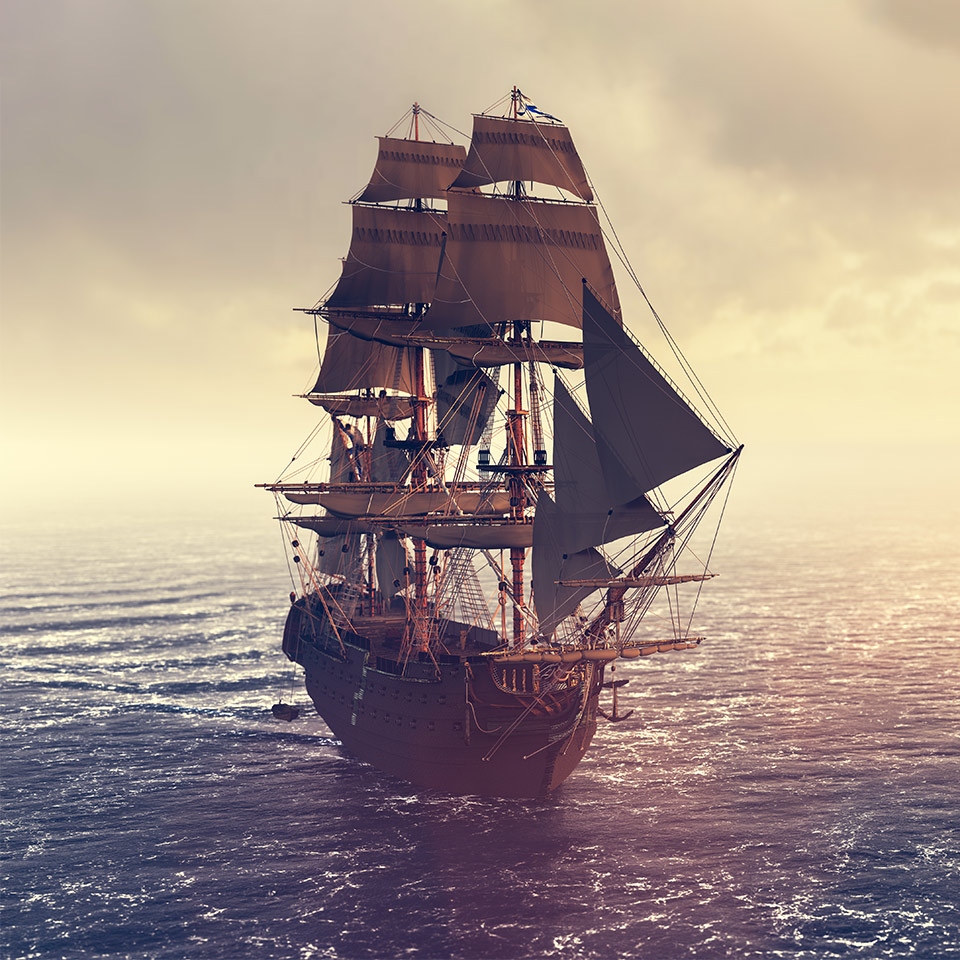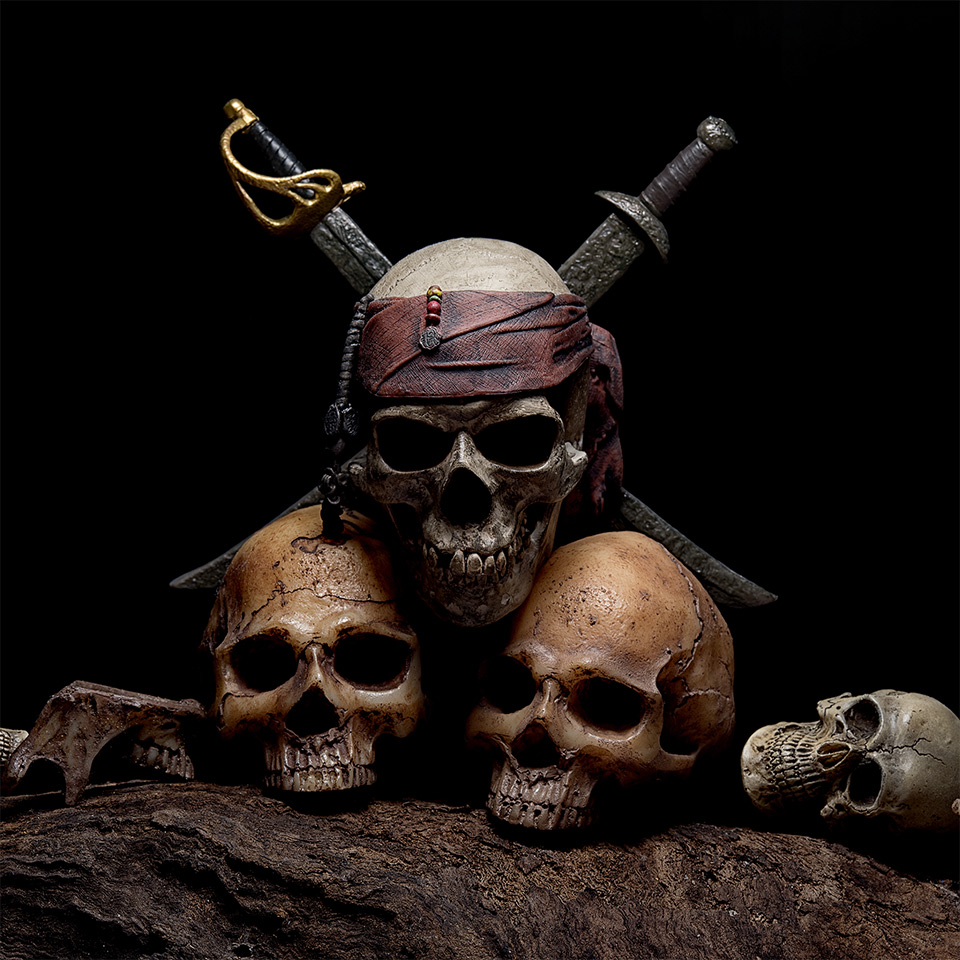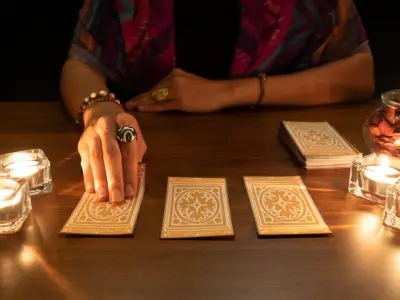The Caribbean was a hotspot for piracy during the so-called “Golden Age of Piracy” - roughly spanning the late 17th to the early 18th century - due to its numerous ports and lucrative trade routes. In this article, we venture into the adventurous and exciting lives of the pirates who ruled the Caribbean.
Jump to:

The Buccaneers
The early days of piracy in the Caribbean were dominated by the buccaneers - a group of sailors and adventurers who made their living attacking Spanish ships and coastal settlements. They originated in the early 17th century as hunters who lived off the meat of wild cattle and pigs on the islands of Hispaniola and Tortuga. They got their name from the Caribbean word “boucan”, which means “grill”, due to their practice of slowly smoking meat over an open fire.
As more buccaneers arrived in the region, they eventually ran out of animals to hunt, so they began raiding the Spanish instead. Since it was the Spanish that drove them from their island settlements, they had no problem pillaging Spain’s ships and colonies.
Some of the most legendary buccaneers include Henry Morgan, who led successful raids against the Spanish in Portobello and Panama City. He was eventually arrested by the English, but was later knighted and made Lieutenant Governor of Jamaica. Francois L'Olonnais was another famous buccaneer and earned a reputation as one of the most ruthless, as he was known for his particularly cruel treatment of Spanish prisoners. Other famous buccaneers were Roche Brasiliano, Edward Mansvelt, and Bartholomew Sharp.
Recommended for you!
Best SellersFamous Pirates of the Caribbean
Henry Morgan
The aforementioned Henry Morgan was one of the most successful and notorious buccaneers of the 17th century. He was born around 1635 in Wales and arrived in the Caribbean as an indentured servant (contracted to work without pay) in the 1650s. He eventually bought his freedom and joined the buccaneers on Tortuga Island, gaining a reputation for his intelligence and bold personality.
In 1668, Henry led a raid against Puerto Principe, Cuba, but his most famous exploits came in the 1670s when he led buccaneer armies against the major Spanish cities. He sacked Panama City in 1671, where his forces spent three weeks pillaging and stealing huge amounts of silver and other expensive loot. He retired as a very wealthy man and was knighted by King Charles II of England, before being appointed Lieutenant Governor of Jamaica. Despite his “successful” end, Henry had a reputation for excessive drinking and mistreating servants. However, his lasting legacy was helping to establish Port Royal, Jamaica, as the unofficial capital of the Caribbean buccaneers. He eventually died in 1688.
Blackbeard (Edward Teach)
Edward Teach, better known as the infamous Blackbeard, became the most feared pirate of the early 18th century, terrorising the Caribbean and Atlantic coast of North America from 1716 to 1718. He was born in Bristol, England, in 1680 and was recognised by the thick black beard that covered most of his face. He also tucked smoking fuses under his hat to cover himself in smoke during battle as a scare tactic.
It’s believed Blackbeard was a crew member under English pirate, Benjamin Hornigold. In 1717, he captured a French slave ship called La Concorde and renamed it the Queen Anne's Revenge, arming it with 40 guns. He expanded his piracy throughout the Caribbean and blockaded the port of Charles Town in South Carolina for ransom. He had complete control over his crew and would occasionally shoot or stab crew members if he felt they would cause trouble.
In 1718, Blackbeard’s piracy came to an end as he was hunted down and brutally killed in battle by a British Navy expedition led by Lieutenant Robert Maynard off the coast of North Carolina. His severed head was attached to Maynard's bowsprit as a trophy. Surprisingly, Blackbeard’s pirating career only lasted two years, but his legend has lived on as one of history's most shameless and successful pirates.
Calico Jack (John Rackham)
Calico Jack was another pirate of the Caribbean and was also born in Bristol, England, in 1682: just two years after Blackbeard. His birth name was John Rackham, but he gained the nickname Calico Jack because of his love for colourful calico clothing.
His journey in piracy saw him starting out as a quartermaster (navigator) under Charles Vane’s pirate crew until 1718. He was then voted captain by the crew after Vane refused to attack a French warship but, unlike other famous pirates, Calico Jack was known to be merciful and didn’t violently torture his captives. Jack then recruited Anne Bonny and Mary Read into his crew - two female pirates dressed as men.
The pirate flag design that we are familiar with today actually came from Jack’s ship. His distinctive flag featured a skull above crossed swords, with the words “A Pirates’ Life for Me” written underneath. This flag design became one of the foremost pirate flags of the era.
In 1720, Jack was brought to Spanish Town, Jamaica and hanged for piracy. His adventures weren’t as lucrative as other pirates, but he left his mark on history as a result of his widely-recognised flag design and his recruitment of female pirates.

Anne Bonny and Mary Read
Anne Bonny and Mary Mead were two infamous female pirates who sailed under Calico Jack in the early 18th century. Anne Bonny was born as an illegitimate daughter of an Irish lawyer in County Cork. She married a sailor (and soon-to-be governor) named James Bonny but left him for a life of piracy in the Caribbean after meeting Calico Jack in a tavern during the time when her husband was responsible for arresting pirates.
Mary Read was also an illegitimate child born in England. She was raised as a boy by her mother and joined the British military as a man before marrying and moving to the West Indies.
Both women, Bonny and Read, joined Calico Jack’s crew while disguised as men in 1720. They were eventually found out, but the crew were very accepting of them since they could fight as well as any man on the ship. They also had a fierce reputation for fighting - when Jack’s crew were too drunk to fight attacking British forces, Bonny and Read were the only ones to resist. Legend says that Bonny fired a pistol and killed a fleeing pirate herself.
Eventually, all three were captured. Mary Read died in prison while Anne Bonny and Calico Jack were convicted of piracy.
Bartholomew Roberts
Bartholomew Roberts was also known as Black Bart and was one of the most successful pirates of the Golden Age, capturing over 400 ships in just three years between 1719 and 1722. He was born in 1682 in Little Newcastle in Wales and started out as a mate on a Barbados sloop (a sailboat with a single mast) before being captured by pirates led by the Welsh pirate, Howell Davis. When Davis was killed in 1719, Bartholomew was elected to be captain by the crew.
He was based in the Caribbean and West Africa, and commanded a multi-ship pirate fleet that was crewed by hundreds of men. He captured merchant vessels, slave boats and fishing boats across the Atlantic. At his peak, he commanded the 26-gun Royal Fortune and led raids on European colonies from North America to Brazil.
In 1722, Royal Navy officer Chaloner Ogle, who captained the HMS Swallow, discovered the Royal Fortune and, after an initial attack and a final pursuit, the HMS Swallow delivered a second attack that resulted in the death of Bartholomew Roberts - killed by a shot to the throat as he stood on the deck. His crew fulfilled his request to be buried at sea before his body could be taken by Chaloner Ogle. They wrapped his body along with his arms and ornaments in the ship’s sail and threw it overboard. His body was never recovered.
Bartholomew’s death was a huge shock to both the pirate world and the Royal Navy. Local merchants and civilians had viewed Black Bart as invincible, with some even treating him as a folk hero. However, despite his reputation and success, he met the same fate as so many pirates before him at the hands of the Navy’s cannons.
Jean Lafitte
Jean Lafitte was a French pirate, born in 1780. He immigrated to Louisiana around 1805 and gained fame as a smuggler and pirate. He operated out of New Orleans and Galveston Island in the early 19th century.
By the 1810s, Lafitte commanded a huge smuggling operation and privateer fleet that preyed on Spanish ships in the Gulf of Mexico. This earned him the nickname “The terror of the Gulf”. However, to American authorities, he portrayed himself as a patriotic privateer to avoid charges of piracy.
When the War of 1812 between the US and the United Kingdom broke out, Jean Lafitte warned the American troops of British invasion plans. He then offered his ships and crew to defend New Orleans against the British. In January 1815, Lafitte's gunners helped US General Andrew Jackson’s outnumbered army in their fight against the British attack. For a short time, Jean Lafitte was considered an American hero.
However, after the war, he returned to his life of pirating and smuggling around Galveston. His base was destroyed by the US Navy in 1821 as a result of pressure to crack down on piracy. Just two years later in February 1823, during an attempt to seize two Spanish merchant ships, Lafitte was wounded in battle and died. He was buried at sea in the Gulf of Honduras.
Charles Vane
Charles Vane was an English pirate who operated out of the Bahamas during the Golden Age of Piracy in the early 18th century. He began his pirate career under the infamous Henry Jennings and, by 1718, Vane had acquired his own ship and was elected captain by his crew. He based his operations on the island of New Providence in the Bahamas and quickly gained notoriety for raiding ships with valuable cargo, but he was known to kill and brutally torture sailors from the ships he seized.
In 1718, Charles Vane engaged in battle with a French warship. Despite being outgunned and outnumbered, he managed to escape capture. This only solidified his reputation for bravery. However, that didn’t last long, as only the next year his crew eventually deposed Vane as a result of the cowardice he displayed during another battle.
He joined another pirate crew, but found himself marooned on an uncharted island following a serious sea storm. He was eventually captured by the British Navy in 1720 and, in March 1721, he was hanged for piracy in Port Royal, Jamaica, aged just 29. He’s now best remembered for refusing to beg for mercy at his execution.
William Kidd (Captain Kidd)
Willam Kidd was a respected privateer from Scotland who turned to piracy and became one of the most infamous pirates of his era.
In 1696, the English crown tasked him to hunt down pirates who were plaguing the Indian Ocean. He was given the ship Adventure Galley and recruited a crew in New York before sailing for the Indian Ocean in 1697. However, he struggled to find pirates and, as his crew grew more and more restless about the lack of pirate loot, he turned to attacking merchant ships. This desperate act resulted in his crew turning against him. They mutinied, killed his gunner, and turned the ship to piracy.
Kidd reluctantly continued working with the mutineers and captured ships across the Indian Ocean and Caribbean, including a treasure-laden Armenian ship. However, after two years at sea, he returned to New York… unaware that he'd been branded a pirate himself.
He was arrested in Boston in 1699 and sent to England for trial. During his trial in London, accounts depicted Kidd as a bloodthirsty villain. He was found guilty of piracy and murder and sentenced to death. Despite his claims of innocence, Kidd was executed by hanging in May 1701. He was left suspended over the River Thames as a warning against piracy. There were some reports that Captain Kidd had left buried treasure behind but, although this idea sparked a lot of legends, no stash was ever found.
We've only scratched the surface of the fascinating history of piracy in this blog, so if you want to fully plunge yourself into the depths of the pirate world then consider enrolling on our accredited History of Pirates Diploma Course for just £29 (save £118)! Our course explores the lives of the many female and male pirates throughout history, the infamous pirates of the Caribbean, and the Golden Age of Piracy.













